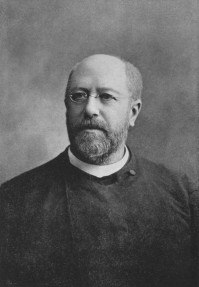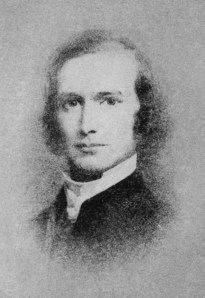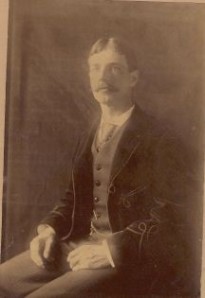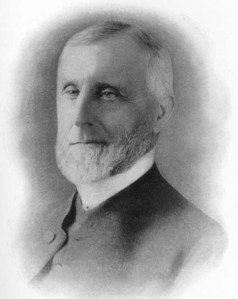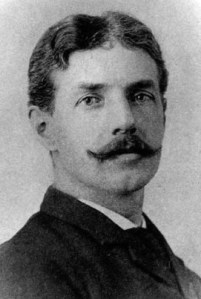1865
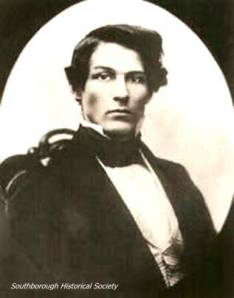 St. Mark’s School founded by Boston chemist and Southborough native Joseph Burnett
St. Mark’s School founded by Boston chemist and Southborough native Joseph Burnett
The first St. Mark’s School building was the old Brigham homestead, at the intersection of Main Street and Marlborough Road. In 1727, the same building had hosted the very first Southborough Town Meeting.
The first Headmaster was the Rev. John Kerfoot Lewis. He lasted less than six months on the job.
1870
The first outside athletic contest in SM history.
Three students and one faculty member take on a boat from the Nobscott Rowing Club in Framingham in a crew race. St. Mark’s loses by two lengths.
1875
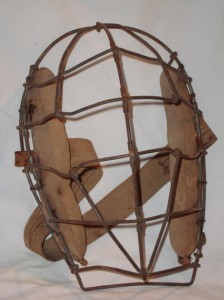 The catcher’s mask is invented by St. Marker Billy Howe (Class of 1877).
The catcher’s mask is invented by St. Marker Billy Howe (Class of 1877).
The mask was first used by Howe in a game against the Harvard freshman in April of that same year. St. Mark’s lost. Playing for Harvard that day was Fred Thayer, who would go on to patent the modern catcher’s mask, inspired by Howe’s invention.
1877
The Vindex is founded.
During its first seventy years, it remains the School’s primary publication, serving as both newspaper and literary magazine (and until 1921 as the School’s alumni bulletin as well).
1878
First-ever St. Mark’s football game against outside opposition: SM shut out by Harvard freshmen.
1884
Groton School is founded.
St. Mark’s does not play Groton at this time, however, and the SM football teams go undefeated in 1884 and 1885. The SM baseball team was also unbeaten in 1885, and for the first time tennis courts were built on campus.
1886
The first SM-Groton game!
Played on a neutral field in Lancaster, MA, the previously unbeaten St. Mark’s Eleven lost. The winning touchdown was scored by Groton master William Greenough Thayer.
1887
The School’s first music teacher, Frank M. Hartley, is hired by Mr. Peck.
Until 1887, music had St. Mark’s had been under the direction of the choirmaster at nearby St. Mark’s Church, as boys from both St. Mark’s and the Fay School made up the bulk of that church’s choir.
Trustees vote to construct a new St. Mark’s School building.
Alumnus Henry Forbes Bigelow (Class of 1884) is commissioned to design the structure. An architectural prodigy at M.I.T., Bigelow is just 20 years old when given the assignment.
1888
A record-shattering blizzard dumps almost four feet of snow on New England.
Drifts as high as thirty feet blanketed Southborough. St. Mark’s was shut down for several days. Music master Frank M. Hartley was a casualty: he died trying to reach shelter.
1889
William Wyatt Barber joins the St. Mark’s faculty to teach Greek.
St. Mark’s football undefeated, tying Groton 26-26.
1890
In the spring, St. Mark’s gets its first win over Groton: a 17-11 baseball victory.
In September, Mr. Peck, 103 students, and 7 teachers move in to the new St. Mark’s main building.
1891
Cloisterball invented and played for the first time.
As St. Mark’s is the only place on the globe where cloisterball is played, in those years where St. Mark’s holds a schoolwide tournament, the winner can rightfully claim to be world champion!
1892
Faculty salaries: the Headmaster made $2500 per year, the Senior Master $1500.
Other faculty salaries ranged from $500 to $1000 a year, depending upon seniority.
1894
In the spring, Headmaster Peck resigns Peck takes half of the St. Mark’s faculty and almost one-third of the student body with him to his new school in Pomfret, CT.
That summer, Founder Joseph Burnett dies.
In September, the Rev. William Greenough Thayer takes over as St. Mark’s sixth Headmaster.
1894
On November 10, SM defeats Groton for the Lions’ first-ever football victory over their rivals.
Sixth Form captain Hamilton Fish Benjamin leads St. Mark’s to a winning campaign, rushing for over 1000 yards and 25 touchdowns. Down 10-0 at the half, he powered his Lions to a come-from-behind 24-10 triumph over Groton.
1895
First performance by the newly established St. Mark’s Octet (spelled “Octette” in those days).
1896
St. Mark’s played an ice hockey game for the first time against an outside opponent.
A “Picked Team” from Harvard shut out St. Mark’s.
1897
William E. Peck, founding headmaster of the Pomfret School, dies.
St. Mark’s students vote to name their brand new athletic building after their former headmaster, calling it “The Peck Gymnasium” (later Benson Auditorium).
1898
Thirty-six St. Markers served during the Spanish-American War.
Two St. Markers gave their lives in that conflict. Eight St. Mark’s alumni charged up San Juan Hill with Col. Roosevelt’s Rough Riders, including George McMurtry, Class of 1896.
1899
The game of Fives is introduced to St. Mark’s. Fives courts are constructed adjacent to the Peck Gymnasium, and an annual competition with Groton ensues. As St. Mark’s and Groton are the only schools in the country with Fives courts, the winner of each year’s meeting could rightfully claim the schoolboy championship of the United States.
Dr. Thayer inaugurates first hands-on community service opportunities for St. Markers.
St. Mark’s students begin volunteering at the Marlborough Boys Club, instructing the gymnasium classes there.
1900
In August, SM alumnus T. Truxtun Hare (Class of 1897) excelled at the Olympic games in Paris.
Hare won the Silver Medal in the Hammer Throw event. Hare would also take home the Bronze Medal in the Decathlon at St. Louis four years later.
1900-01
St. Mark’s plays its first full ice hockey schedule.
St. Mark’s was unbeaten against both schoolboy and college freshman opponents. They defeated a previously undefeated St. Paul’s team over Christmas break on New York’s St. Nicholas rink. The previous winter, St. Mark’s played only one game, but emerged with their first hockey victory, 5-1 over the Harvard freshmen. From the next 20 years, there would be only three varsity sports at St. Mark’s: football, hockey, and baseball. St. Mark’s football went undefeated in 1899, 1909, and 1913. In 1902, however, the team went 0-11 and was outscored 255-0.
1907
Shutting out St. George’s, Roland G. Wood ’09 became the first SM student to pitch a no-hitter.
1908
English master George B. Fernald revitalizes the Dramatic Club at St. Mark’s.
Director Fernald inaugurates a series of annual productions featuring St. Mark’s students in “quality plays”, including Oliver Goldsmith’s She Stoops to Conquer, Richard Brinsley Sheridan’s The Critic, Pinero’s The Amazon and The Cabinet Minister, and Shakespeare’s Comedy of Errors and Midsummer Night’s Dream.
1909
Music instructor Joseph Handley expands the School’s music program.
Handley revitalizes the St. Mark’s Glee Club, and puts together the first major combined concert featuring performances by the Glee Club, the Octet, the Mandolin Club, and the Banjo Club.
1911
J. Augustus Prendiville becomes the first teacher of Manual Arts associated with St. Mark’s.
Former President Theodore Roosevelt visits St. Mark’s late that fall.
Roosevelt, on the eve of launching his revolutionary third party Bull Moose candidacy for the presidency, presented a gift to the School: one of the moose heads which now adorns the dining room.
1912
Tuition was $900 per year.
1914
The Great War begins.
Although the United States remained neutral, three alumni—William H. Emory ’06, Wickliffe
Preston Draper ’09, and John B. Dodge ’12, would all enlist in the British Army before the year was out.
1915
Dr. Thayer and St. Mark’s celebrate the 50th anniversary of the School’s founding.
1916
Several St. Markers are part of the Lafayette Escadrille: American pilots flying for France.
Stephen Galatti ’06 directed the American Field Service—a corps of ambulance drivers and stretcher bearers for the Allies—throughout the War.
In the fall, Military training begins for Fifth and Sixth Formers at St. Mark’s.
1917
In April, Edwin Austin Abbey ’07 became the first St. Marker to die in the War.
A Lieutenant with the Canadian Mounted Rifles, he was killed in action at Vimy Ridge.
The United States enters the war.
Over the next two years, more than 700 alumni would serve, and 20 St. Markers would make the supreme sacrifice.
Throughout the war, Dr. and Mrs. Thayer would correspond with St. Markers in uniform.
1918
In October, George McMurtry (SM Class of 1896) would earn the Congressional Medal of Honor.
As second-in-command of the now famed Lost Battalion, the veteran Rough Rider would take part in one of the most well-known and most dangerously challenging episodes of the war.
1918
At 11 AM on November 11—the 11th hour of the 11th day of the 11th month—the war would end.
On that same day, just two minutes before the ending of hostilities, an exploding shell would bury Richard Mather Jopling ’12, a stretcher bearer with the American Field Service. In the silence that followed, his comrades would dig him out, but he would eventually die of his wounds.
1919
Work began on an expansion of the St. Mark’s Chapel to honor those who served in the War.
1920s
1920-Dr. Thayer inaugurates Brantwood Camp as a permanent service opportunity for St. Markers.
1921- St. Mark’s enrollment reaches 173, the School’s largest to date.
1921-Crew was reintroduced to St. Mark’s athletics, bringing the number of varsity sports to four.
1920s
1921- English master Chauncey Lyman Parsons takes over Direction of the St. Mark’s Dramatics Club. Shakespeare’s Taming of the Shrew and Oscar Wilde’s The Importance of Being Earnest are among his quality productions over the next decade.
1921-James Hilton Marr becomes the first full-time music teacher at St. Mark’s. Although he would take one or two classes a year teaching English, German or Latin, his principal responsibilities included teaching music appreciation, theory, ear training, and sight reading to all First and Second Formers; to direct both the Choir and the Glee Club; to work with the Quartet or Octet; and to play the organ in the Chapel. He also assisted Mr. Parsons in introducing Gilbert and Sullivan operetta’s to the Dramatic Club’s repertoire.
1920s
1922-A large Lion statue is donated to St. Mark’s. It is given in honor of the four Harris brothers who graduated from St. Mark’s between 1917 and 1921 by their father. By 1925 it will find its permanent home just west of the Chapel, beautifully framed by the cloister arch.
1924-Kleber Hall becomes the first teacher of art at St. Mark’s. That same year, long-time manual arts teacher J. Augustus Prendiville is finally listed in the catalogue and yearbook as an official member of the St. Mark’s faculty.
1920s
1925-The first History of St. Mark’s School, by Albert Emerson Benson (SM Class of 1888) is published.
1927- Roland Darrow Sawyer joins the SM faculty to teach mathematics. Known as “Butch” to his students and “Tom” to his colleagues, Mr. Sawyer will coach football and introduce interscholastic basketball at St. Mark’s.
1930s
1930- Dr. Thayer retires after 36 years as Headmaster. Francis Parkman ’15 is named his successor.
1931- William E. Gaccon joins the St. Mark’s faculty. He helps introduce the sport of soccer to the School.
1932- William Wyatt Barber, Jr. ’28 joins the St. Mark’s faculty. In addition to becoming a colleague of his father, the Senior Master, he will take over the reins of the St. Mark’s hockey team from his old mentor Edwin Cummings Lawrence.
1932-Outstanding production of Shakespeare’s Hamlet put on by the Dramatic Club. Mr. Parsons directed and Sixth Former John Cromwell, later a professional actor, played the lead.
1930s
1932-Choate House acquired by St. Mark’s. First used as a facility for teaching science (with laboratories and classrooms on the ground floor), it eventually was converted into faculty apartments.
1934- Coach Sawyer’s football team is undefeated.
1934-Dr. Thayer dies. Funeral service is held in Belmont Chapel.
1935-The Elkins Field House is built. David Elmer Coe becomes Athletic Director.
1930s
1936-Polio epidemic strikes St. Mark’s, cutting short the school year.
1937-William Wyatt Barber, Sr. retires after 48 years of teaching and 40 years as Senior Master.
1939-War breaks out in Europe. Stephen Galatti ’06 returns to his post as Director of the American Field Service and prepares to organize and supervise ambulance services for another war. Albert Cameron Burrage ’37 joins the AFS and trains for active duty. First World War veteran John B. Dodge re-enlists in the British Army.
1940s
1940-St. Mark’s celebrates its 75th Anniversary. More than 500 guests attend weekend festivities. First major fundraising drive to grow the St. Mark’s endowment is initiated.
1940-John B. Dodge ’12 becomes a Prisoner of War. First U.S. peacetime draft (the Selective Service Act of 1940) becomes law. St. Mark’s alumni flock to enlist.
1941-Dr. Parkman reintroduces military training at St. Mark’s.
1940s
1941- First St. Mark’s casualty of the war. Robert Randall ’35, serving in the Merchant Marine, goes down with the SS Astral, torpedoed by a German submarine on December 2nd, 1941: five days before the attack on Pearl Harbor.
1941-Pearl Harbor attacked: U.S. enters Second World War
1942-Dr. Parkman introduces an accelerated graduation program at SM which included a summer session, for St. Mark’s students intent on either enlisting or entering college early to join officers’ training units.
1940s
1942-Francis Parkman announces his resignation as headmaster, so he can enlist in the Army.
1942-J. Stanley Sheppard joins the St. Mark’s faculty as Director of Music. Mr. Sheppard introduces the annual production of original musical comedies, and revitalizes the teaching of music at St. Mark’s.
1943-The Rev. William Brewster becomes the School’s eighth headmaster.
1944-John B. Dodge ’12 takes part in the now famous Great Escape from a German POW camp.
1940s
1945-The war ends. During WWII, more than 900 St. Markers are in uniform. 33 alumni and one faculty member give their lives.
1948-William Brewster resigns as St. Mark’s headmaster. He moves to Texas to help found St. Stephen’s School: the first integrated and coed boarding school in the South. William Wyatt Barber Jr. becomes the ninth headmaster of St. Mark’s School.
1950s
1950-During the Korean War, more than 100 St. Markers served, and four gave their lives. Frederick R. Avis joins the SM faculty In the 1950s, under Mr. Avis, St. Mark’s modernized its science program, earning national recognition for his efforts.
1950s-The decade of the 1950s also brings unprecedented athletic success to St. Mark’s. Mr. Gaccon’s Soccer team won Private School League (Gummere Cup) championships in 1954 and 1958. (Continued on next slide)
1950s(continued)
Coach Benny Howarth’s football team was undefeated in 1956. David Coe’s wrestling squad was undefeated in three different seasons, winning 26 in a row and taking the Graves-Kelsey title in 1951. Mr. Barber’s hockey team enjoyed eight winning seasons during the decade, and won the Private School League championship in 1959. Varsity basketball claimed league titles in 1951 and 1954. Benny Howarth’s Varsity baseball teams were champions in 1952, 1954, and 1959 (unbeaten during the latter campaign), while Varsity tennis took the title in 1952 and the crew program enjoyed regular success. Throughout the 50s and 60s, Mr. Barber assembled an outstanding faculty, and St. Mark’s became one of the leading private schools in the country.
1960s
1963- David Webster ’47 became the only St. Mark’s casualty of the Vietnam conflict.
1965- St. Mark’s celebrated its Centennial. In May, some 1300 guests enjoyed a weekend of festivities, presentations, and games. For the first time, St. Mark’s endowment surpasses $1 million.
1965- That September, integration arrives, as St. Mark’s School admits its first students of color.
1966- In March, a terrible fire sweeps through the main building, destroying the New Wing.
1960s
1966- St. Mark’s School: A Centennial History by Edward T. Hall ’37 is published.
1967-William Wyatt Barber Jr. announces his retirement. He will step down in 1968, after 20 years as Headmaster.
1968- Edward T. Hall ’37 becomes the tenth Headmaster of St. Mark’s School. During Mr. Hall’s tenure, the new Art-Music building is completed, the library is significantly expanded, rules are liberalized, and steps are taken toward coeducation.
Early 1970s
1972-The Southborough School for Girls is founded by Pierson F. Melcher.
A progressive, democratic institution, it is coordinated with St. Mark’s.
1973- John Pickering ’74 wins the individual Cross Country championship of the Private School League.
Pickering earns the very first Varsity letter in Cross Country ever awarded at SM
1974- Edward T. Hall steps down. The Rev. Robert R. Hansel becomes Headmaster.
Late 1970s
1975- In the Fall, both Varsity football and Varsity soccer are undefeated.
1977-Southborough School closes – St. Mark’s becomes co-ed.
1978-Robert Hansel steps down as Headmaster.
1979- Faculty member William Evill serves one year as Acting Headmaster.
Subsequently…
Mark Barlow becomes Headmaster of St. Mark’s. During Mr. Barlow’s tenure, St. Mark’s addresses a number of complex social issues, a number of outstanding teachers join the faculty, and a major capital Campaign for St. Mark’s triples the endowment.
Chris Mabley is Headmaster, further equalizing and enriching the St. Mark’s coed experience andfashioning the welcoming, inclusive school of today.
Tony & Elsa Hill are Heads of School, expanding the facilities (a new Athletic Center, a new Arts building,a new dormitory, and much more.
Recently…
John C. Warren ’74 becomes Head of School, and he continues the work of his predecessors, striving to enhance the School’s intellectual and academic reputation.
